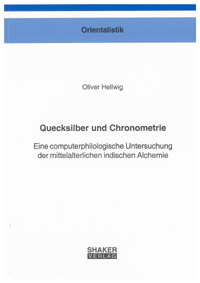Oliver Hellwig, Quecksilber und Chronometrie. Eine computerphilologische
Untersuchung der mittelalterlichen indischen Alchemie.
Aachen: Shaker Verlag 2009. Berichte aus der Orientalistik. 128
pp. ISBN 978-3-8322-8182-3. € 39.80.
Oliver Hellwig, Wörterbuch der mittelalterlichen indischen Alchemie.
Eelde: Barkhuis / Groningen: University of Groningen, University
Library 2009. Supplements to eJournal of Indian Medicine
2. vi;615 pp. ISBN 978-90-77922-62-0. € 67.84.
Though this is nowhere mentioned in the titles or subtitles of these two publications,
or amongst other bibliographic particulars, it is stated explicitly on p.
7 of the first of them that the two are to be seen as the first part and second part
respectively of a study on Indian alchemy. It therefore makes sense to discuss
them together.
The author is a specialist on alchemical literature in Sanskrit and has devoted
much time and energy to the systematisation of the knowledge contained in
these. One of the problems encountered during this endeavour was that of the
chronology, both absolute and relative, of the texts. Hellwig´s solution consisted
in the use of data processing techniques based on mathematical-algorithmic
text analysis to process large amounts of text, in a way next to impossible by
traditional methods. By this means, various types of information were subjected
to analysis, and it transpired that the most promising analysis was based on that
of rules pertaining to the same alchemical processes.
The results of the analysis are, as detailed in the first work, absolute and relative
chronologies of the considered alchemical texts which in some cases are in
accord with commonly held views on them, in others differ markedly.
The major part of the ƒirst book is devoted to the explanation of the mathematical
basis and procedures for the analysis. On this, Hellwig writes (p. 8 of
the first work):
Die Darstellung mathematischer Zusammenhänge ist zwangsläufig ein Kompromiss.
Für Informatiker und Mathematiker sind die detailliert erklärten Schritte
trivial, während sie für andere Leser wahrscheinlich zu kurz dargestellt sind.
Der Text richtet sich trotzdem eher an Philologen als an primär mathematisch
ausgebildete Leser.
If indeed `philologists´ are the primary target group of this work, then I fear
that they will derive little profit from most of it. The major part will probably
appear to those without the requisite mathematical knowledge to be simply gobbledygook,
not made better by a style of explanation so compact as at times to
border on the obtuse. The `philologist´ without the requisite mathematical
knowledge will, thus, most probably be able to really comprehend only the
chronological tables (such as on pp. 109 and 113), but without being able to fully
understand, let alone verify, how these were arrived at. This cannot be helped, but it does make one ask what image of `philologists´ the author had in
mind when deciding that these should constitute the primary target audience.
Moreover, it is rather unfortunate that the DIN A5 format of the book occasioned
a reduction in type size that is sure to cause difficulties to many readers.
True, the work would have had to have some more pages if the original font
used, and reduced in size for printing, had been larger, but it would surely have
afforded the eyes of many a reader greater relief. On the other hand, it has an
index, which is not something one necessarily expects in such a relatively small
book. This is another example, quite apart from the work´s contents, of how sincerely
and painstakingly Hellwig operates.
The second work presents another set of results derived by the method described
in the first work, and is very different from this. Though it is also much
more voluminous, of approximately imperial octavo format and with larger
print, the significant difference lies, clearly, in its contents. Basically, these consist
of a dictionary of about 400 technical alchemical terms. But what a dictionary!
Each termis accompanied by extensive explanations, whenever appropriate
with line sketches, along with synonyms, cross-references and, of course, citations
from the original sources accompanied by careful translations. The `philologist
´ will garner not only profit, but also real pleasure from using this work,
all the more so since the actual dictionary part is prefaced by a concise and yet
comprehensive, well-organised introduction into alchemistic terminology, with
many explanatory line sketches. There are also extensive indices: an index of
plant names, an index rerum, a Sanskrit index verborum and an index locorum.
Further, there is also a section in which alchemical procedures are explained in
diagram and dendrogram form.
It needs to be pointed out that this second book is not the only outcome of
the investigations described in the first. Hellwig has, subsequently, also published
various articles in which other results have been set forth, the last, to my
knowledge, in 2014*.
RAHUL PETER DAS
(das.rp@t-online.de)
*`Materialgruppen in der indischen Alchemie´, Zeitschrift der Deutschen Morgenländischen
Gesellschaft 164 (2014): 451-468. Earlier articles by Hellwig are mentioned in the list
of sources utilised for that article.
|

